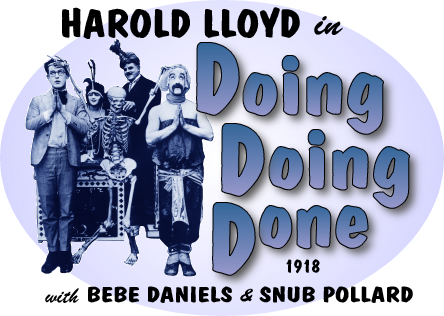

Harold Lloyd began film work in 1913 as an extra with Universal, a colleague being Hal Roach who later set up as a producer and engaged Lloyd as his leading comedian in the character of "Willie Work." Then after a short spell with Keystone, he returned to Roach in the character "Lonesome Luke."
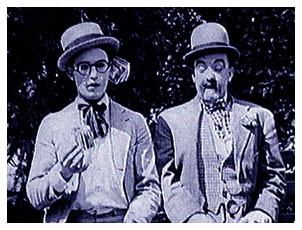 Early in 1915, both
Bebe Daniels, aged 14, and Harry "Snub" Pollard joined,
and the three proceeded with one and two-reelers for two years,
making about eighty. Early in 1917, Lloyd had the inspiration
of the glasses, and one-reelers with the character, of which "Doing-Doing-Done"
is typical, were made at the rate of one a week till April 1919.(1)
Early in 1915, both
Bebe Daniels, aged 14, and Harry "Snub" Pollard joined,
and the three proceeded with one and two-reelers for two years,
making about eighty. Early in 1917, Lloyd had the inspiration
of the glasses, and one-reelers with the character, of which "Doing-Doing-Done"
is typical, were made at the rate of one a week till April 1919.(1)
Then Lloyd proceeded with two-reelers and gradually longer films, every one of which was hugely successful. "Grandma's Boy" (1922), "Safety Last" (1923), "Speedy" (1928), and the talkie "Welcome Danger" (1929) will be happily recalled. Snub Pollard went on to make comedies on his own, including the inventive "It's a Gift" (1923 Hal Roach short). Bebe Daniels proceeded to a career as consistently successful as any star. Between leaving the Hal Roach unit in May 1919, after the second "glass character" two-reeler "Captain Kidd's Kids," and up to 1933 when she appeared with Lupino Lane and Clifford Mollison in "A Southern Maid" in England for B.I.P., she starred in over 30 films of consistently good quality, the later silents being excellent comedies. Her films include "North of the Rio Grande" (1922, Jack Holt), "Glimpses of the Moon" (1923, Nita Naldi), "Monsieur Beaucaire" (1924, Rudolph Valentino, by Sidney Olcott), "Wild, Wild Susan" (1925, Rod la Rocque), "Swim, Girl, Swim" (1927, with the witty titles), "The Fifty-Fifty Girl" (1928, Neil Hamilton), "Rio Rita" (1929, John Boles), "Reaching for the Moon" (1931, Douglas Fairbanks, Sr.), and "The Maltese Falcon" (1931, Ricardo Cortez). The impression that "Hi, Gang!" (1941) was Bebe Daniel's first film would appear to be inaccurate.
The germ of three successful careers is well in evidence in the 1918 "Doing-Doing-Done." Though this lacks the genius of the contemporary "Easy Street," it was shot in less than a quarter of the time and was not an outstanding specimen, both "Town Tricks" and "Look Out Below" being more inventive, to name at random two which are, unfortunately, not available.
"Doing-Doing-Done" is a gag comedy, the gag framework
or "story" being merely a progressive reversal of stealings
between rival swindlers.(2) The opening
is briskly descriptive: Miss Goulash concludes a séance
with a greatly impressed client. Professor Goulash leaves his
"effects" room to collect the takings, and both change
and go out, putting up a 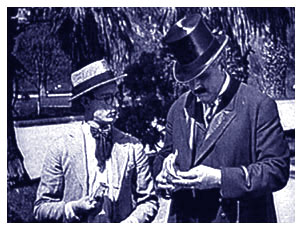 notice,
"Will return at 4 p.m."
notice,
"Will return at 4 p.m."
This brief opening sequence, lasting about one minute, uses no less than five sets (séance room, effects room, hall, dressing room, and exterior of house), all of which appear again later on. This variety adds to the slick effect so typical of Lloyd's comedies. The only fault in the sequence has been gratuitously added - an inserted close-up of a "Will return at 4 p.m." notice which is hopelessly dissimilar from the mid-shot, causing a ludicrous discontinuity.
One excellent and typical mid-shot introduces Lloyd and Pollard with a gag that ingeniously expresses their dubious business morality. We first see some swaying bushes and a cop walks by. Then the bushes part, and the two emerge. Suddenly, they retreat, the bushes magically opening for them. The cop walks back. Then they emerge again. Cut-in is a shot of Professor Goulash settling down on a seat in the park. The two approach. Harold is being studiedly nonchalant, whistling lightly.
Two redundant titles have been inserted at this point, the
action itself being perfectly clear.
a. L.S. They walk past the Professor, pause behind a bush . .
.
b. CM.S. From suitcase labeled "Phoney Jewelry Co."
Harold takes a ring . . .
c. C.S. . . . and hands it to Snub . . .
d. L.S. . . . who drops it in the path, then searches wildly,
disturbing the Professor who also begins to search. Harold hides
the suitcase, strolls in, finds the ring, and remarks . . .
e. TITLE "By Jove, what a fine ring!"
f. CM.S. . . . and is walking off, but the Professor takes out
a wad of notes and offers a few, then more - then Harold takes
the wad and returns the few and hands over the ring, and . . .
g. L.S. . . . the Professor hurries off, Snub comes back, and
the two deftly link arms and walk off.
This is decidedly satisfactory. Lloyd's acting is succinct,
the action is witty, the narrative value brisk. Pollard puts in
a witty touch as he looks after the victim, tilts his hat, and
crosses his legs. This actor came from an Australian vaudeville
act. His amazing moustache was born when he accidentally reversed
a pair of Kaiser Wilhelm moustaches  while
trying them on, according to Lloyd in his happy autobiography
"An American Comedy" (Longmans, Green & Co. 1928).
while
trying them on, according to Lloyd in his happy autobiography
"An American Comedy" (Longmans, Green & Co. 1928).
Harold and Snub next proceed to work the phony ring routine
on a whole group of people, including Miss Goulash. She, however,
isn't having any, and when the swindlers withdraw, she follows
them. The explicit narrative value, apt and typical gags, and
general comic exuberance of the shots making up the next sequence
demand quotation . . .
a. M.S. The two count out their spoil, Miss Goulash watches from
behind.
b. C.S. She has an idea: takes her money from her bag, and . .
.
c. M.S. . . . places the bag near Harold's feet, and hurries away.
. . Fade out
d. M.S. (Fade-in) (as c) . . . and returns with the Cop. The two
still count money. The Cop nudges them, and they whip it away
like guilty lightning. They deny any knowledge of the bag, so
the girl points to it. Harold picks it up with a laugh that would
disarm any decent Cop. Snub looks incredibly innocent.
e. CM.S. The Cop grabs it and hands it to the girl. She opens
it and exclaims . . .
f. TITLE "I had over 200 dollars in my bag!"
g. CM.S. (as e) . . . she cries. Cop looks into empty bag.
h. CM.S. Harold and Snub uneasily handle their money.
i. M.S. The Cop swings his truncheon. Harold kisses the money
good-bye. The Cop grabs it and hands it to the girl, who . . .
j. C.S. . . . puts it, and her own also, back into her bag, smiling.
k. M.S. (as g) She goes. Cop looks at the two . . .
l. M.S. (taken with the Cop's back hunched threateningly, filling
the foreground) They get up, link arms, stroll off; look back,
hurry along; look back again, break into panic dash out of the
picture . . .
Harold's uneasy calm, Snub's aloofness, Bebe's wide-eyed innocence, and the Cop's uncompromising ferocity to the former and smiles at the latter are very joyous. The gag in the last shot, which uses the same camera angle as Chaplin's first walk along Easy Street, is one of he oldest in films, but seldom has it been executed with such supreme polish.
They fetch up outside the Goulash dive and almost walk into
another Cop, but instead wheel sharply and enter. The Lloyd-Pollard
timing, even in simple turns such as this, is 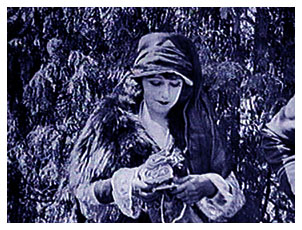 worth
noting. Lloyd lent to his comedy a slick precision of movement
superior to that of Chaplin.
worth
noting. Lloyd lent to his comedy a slick precision of movement
superior to that of Chaplin.
Harold enters the séance room and dons the Professor's clothes. Snub enters the dressing room and dons female garb with veil. Crosscutting condenses the action. The Cop is defeated by the apparitions, and withdraws. Harold unmasks Snub with several gags, inimitably put over. They then put up the "Open for Business" sign. Here again, a hopeless close-up has been inserted by somebody.
In mid-shot, Harold sits at the medium's table, becoming increasingly uneasy as a hand moves, a mummy breathes out smoke, and feathers flap. He reverts to his own straw hat and retreats - then sees Snub operating the effects. Gaily, in full long shot, they dance with tambourines - and Miss Goulash enters, peeps in, and withdraws. Then she knocks and enters to find them doing an incredible act, Harold arm-waving and Snub salaaming.
Snub is only just prevented from braining her with an enormous mallet on realizing who she is. Then she applies her knowledge of the effects by causing a skeleton to appear and disappear, enabling Harold to turn on his always-amusing expression of horrified dismay. Snub next steals her money. But Harold steals it from Snub, and Bebe steals it back from Harold - all with immense virtuosity.
As the two hurry to leave, the Professor returns - futile
mix from long shot to mid-shot, quite foreign to the Lloyd technique,
has got in here and causes confusion. After a brisk chase, including
a combined backward somersault that floors the Professor, Harold
is flung out and so is Snub, the action being . . .
a. L.S. (exterior, house door in background) Harold comes flying
out, overturns, and rolls down steps. Snub ditto, flying foot
walloping Harold's head, ends sitting beside him.
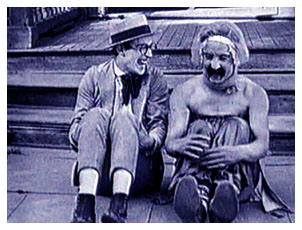 b. M.S. They laugh. Snub whispers,
feels in dress for money, gets up frantically, Harold winks at
audience . . .
b. M.S. They laugh. Snub whispers,
feels in dress for money, gets up frantically, Harold winks at
audience . . .
c. M.S. (higher angle) Snub gives up searching. Harold feels for
the money in his pocket, frantically feels, gives up. Snub knocks
him down. He bounds up enraged, and . . .
d. L.S. . . . chases Snub away into the distance.
FADE OUT THE END
Again, this is all perfectly explicit but has been weakened by the insertion of two titles in shot (c) which laboriously explain the obvious financial situation. A precisely similar fault occurs at the end of "Look Out Below." Many of the Harold Lloyd films had uninspired titles.(3) Looking at the camera (shot b) was unusual at this period, particularly with Lloyd - but has since become a stock gag with Oliver Hardy, Groucho Marx, and Tom Walls.
The running-away ending is satisfactorily applied to comedies of this type, particularly as they were produced and shown at one-a-week, so next week one saw the same three principals in some new racket. On the other hand, many (including the "Safety Last" prototype, "Look Out Below") did have a romantic Harold-and-Bebe ending in the Chaplin "Easy Street" manner.
It would be absurd to pretend that "Doing-Doing-Done" is as good a film as "Easy Street." Chaplin's work is profound (at least in patches), and there are unquestionable touches of genius. Little gestures of wiping boots on police jackets and squinting through earpieces are genius as inimitable as the warm softness of a Morland or the stirring thrill of the Valkyrie.
Harold Lloyd never set out to do what Chaplin did.(4) His object, perfectly fulfilled, was sparkling comedy. And this he put over with a mechanical precision and effervescent personality that are delightfully amusing, if perhaps shallow. Buster Keaton, his agile imperturbability contrasting with generally uncontrolled mechanical surroundings, came somewhere in between the two.
Each failed to beat the others on their own ground. Thus Chaplin's tightrope act in "The Circus" was pale beside the skyscraper climb in Lloyd's "Safety Last." Neither Chaplin nor Lloyd could have approached Keaton's trouble with the gun his engine towed in "The General." The Keaton two-reelers (1920-23) were available in France on 9.5mm before the war, so it is probable that we shall have them on our screens one day if Messrs. Pathescope do their duty.
The one and two-reel comedies from their discovery up the late 1920's are a joy that no noise can lessen. They were inventive and funny and are funny still - and always will be - both to the man (and boy) in the street and to the lover of cinema who can look a little deeper and see subtle touches and enjoy the ideas and personalities of these admirable comedians.
FOOTNOTES
(1) While a great admirer of Harold Lloyd's work from 1918 on, I have never been a fan of the early comedies and have often wondered what audiences saw in them that kept them on the screen week after week. This 1942 description does the job admirably. Fortunately, a good quality print of "Are Crooks Dishonest?" is available on a collection of Lloyd shorts from Kino International (U.S.) and MK2 (UK). Also, a boxed set of Harold Lloyd DVDs which his granddaughter Suzanne Lloyd Hayes has produced includes most of the brilliant films that made him one of the three greatest comedians of the silent era. (KB)
(2) The 'lost ring' scam appears again in the later Roach/Paul Parrott comedy "Fingerprints." (Dave Wyatt)
(3) This was due to the Pathescope reissues, not to the Roach originals. H.M. Walker was one of the leading title-writers. (KB)
(4) Lloyd's early incarnations as Willie Work and Lonesome Luke were imitations of Chaplin, as Lloyd himself acknowledged. (KB)